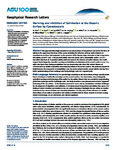Warming and Inhibition of Salinization at the Ocean's Surface by Cyanobacteria
| dc.contributor.author | Wurl, O | |
| dc.contributor.author | Bird, K | |
| dc.contributor.author | Cunliffe, M | |
| dc.contributor.author | Landing, WM | |
| dc.contributor.author | Miller, U | |
| dc.contributor.author | Mustaffa, NIH | |
| dc.contributor.author | Ribas-Ribas, M | |
| dc.contributor.author | Witte, C | |
| dc.contributor.author | Zappa, CJ | |
| dc.date.accessioned | 2020-06-20T08:56:23Z | |
| dc.date.issued | 2018-05-16 | |
| dc.identifier.issn | 0094-8276 | |
| dc.identifier.issn | 1944-8007 | |
| dc.identifier.uri | http://hdl.handle.net/10026.1/15781 | |
| dc.description.abstract |
<jats:title>Abstract</jats:title><jats:p>This paper describes high‐resolution in situ observations of temperature and, for the first time, of salinity in the uppermost skin layer of the ocean, including the influence of large surface blooms of cyanobacteria on those skin properties. In the presence of the blooms, large anomalies of skin temperature and salinity of 0.95°C and −0.49 practical salinity unit were found, but a substantially cooler (−0.22°C) and saltier skin layer (0.19 practical salinity unit) was found in the absence of surface blooms. The results suggest that biologically controlled warming and inhibition of salinization of the ocean's surface occur. Less saline skin layers form during precipitation, but our observations also show that surface blooms of <jats:italic>Trichodesmium</jats:italic> sp. inhibit evaporation decreasing the salinity at the ocean's surface. This study has important implications in the assessment of precipitation over the ocean using remotely sensed salinity, but also for a better understanding of heat exchange and the hydrologic cycle on a regional scale.</jats:p> | |
| dc.format.extent | 4230-4237 | |
| dc.format.medium | Print-Electronic | |
| dc.language | en | |
| dc.language.iso | en | |
| dc.publisher | American Geophysical Union (AGU) | |
| dc.subject | cyanobacteria | |
| dc.subject | remote sensing | |
| dc.subject | sea surface microlayer | |
| dc.subject | sea surface salinity | |
| dc.subject | sea surface temperature | |
| dc.subject | skin layer | |
| dc.title | Warming and Inhibition of Salinization at the Ocean's Surface by Cyanobacteria | |
| dc.type | journal-article | |
| dc.type | Article | |
| plymouth.author-url | https://www.ncbi.nlm.nih.gov/pubmed/29937608 | |
| plymouth.issue | 9 | |
| plymouth.volume | 45 | |
| plymouth.publication-status | Published | |
| plymouth.journal | Geophysical Research Letters | |
| dc.identifier.doi | 10.1029/2018gl077946 | |
| plymouth.organisational-group | /Plymouth | |
| plymouth.organisational-group | /Plymouth/Faculty of Science and Engineering | |
| plymouth.organisational-group | /Plymouth/Faculty of Science and Engineering/School of Biological and Marine Sciences | |
| plymouth.organisational-group | /Plymouth/REF 2021 Researchers by UoA | |
| plymouth.organisational-group | /Plymouth/REF 2021 Researchers by UoA/UoA07 Earth Systems and Environmental Sciences | |
| plymouth.organisational-group | /Plymouth/Users by role | |
| plymouth.organisational-group | /Plymouth/Users by role/Academics | |
| dc.publisher.place | United States | |
| dcterms.dateAccepted | 2018-04-26 | |
| dc.rights.embargodate | 2020-6-24 | |
| dc.identifier.eissn | 1944-8007 | |
| dc.rights.embargoperiod | Not known | |
| rioxxterms.versionofrecord | 10.1029/2018gl077946 | |
| rioxxterms.licenseref.uri | http://www.rioxx.net/licenses/all-rights-reserved | |
| rioxxterms.licenseref.startdate | 2018-05-16 | |
| rioxxterms.type | Journal Article/Review |


